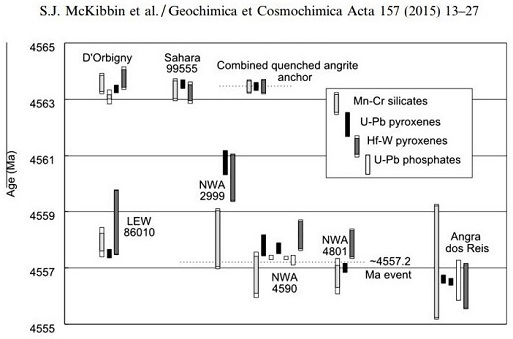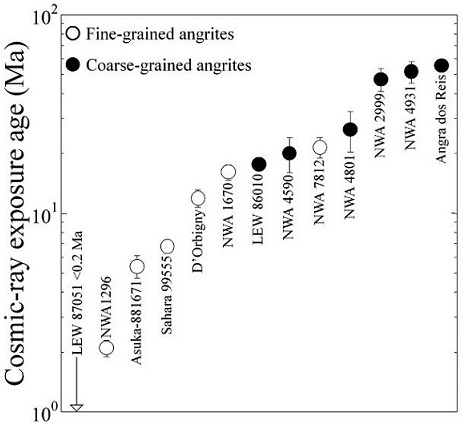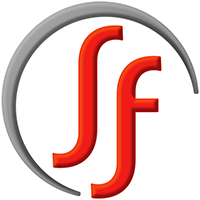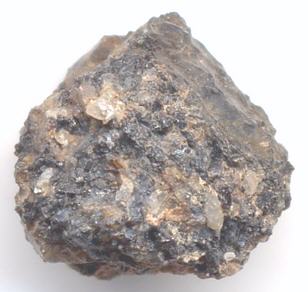NWA 4590
AngriteType of evolved achondrite meteorite that represent some of the earliest stages of asteroidal differentiation and magmatism in our solar system. Angrites are named for the Angra dos Reis meteorite, which fell in Rio de Janeiro, Brazil, in early 1869. They are basaltic (mafic) rocks, often containing porous areas, and Click on Term to Read More
Sub-volcanic/Metamorphic
Found June 2006
30° 19.025′ N., 4° 56.573′ W. Numerous fragments with a combined weight of 212.8 g and constituting a single, very fresh, friable, fusion-crusted stone were found 21 km south-southwest of Tamassint oasis and 18 km south of Agoult, Morocco near the Morocco–Algeria border. The fragments were purchased by G. Hupé and an analysis was conducted at the University of Washington in Seattle (A. Irving and S. Kuehner). Northwest Africa 4590 has been determined to be a previously unsampled angriteType of evolved achondrite meteorite that represent some of the earliest stages of asteroidal differentiation and magmatism in our solar system. Angrites are named for the Angra dos Reis meteorite, which fell in Rio de Janeiro, Brazil, in early 1869. They are basaltic (mafic) rocks, often containing porous areas, and Click on Term to Read More type. This classification was verified by an O-isotopic analysis completed at Carnegie Institute in Washington D.C. (D. Rumble III).
 The first-time discovery of the rare mineralInorganic substance that is (1) naturally occurring (but does not have a biologic or man-made origin) and formed by physical (not biological) forces with a (2) defined chemical composition of limited variation, has a (3) distinctive set of of physical properties including being a solid, and has a (4) homogeneous Click on Term to Read More rhönite in an angrite has been made in a sample of NWA 4590 at the University of Washington, Seattle (Kuehner and Irving, 2007). The rhönite mineral is associated with ferric iron in NWA 4590, which, when taken together with other Fe-metal–oxide associations present in some angrites, is indicative of an oxidizingOxidation and reduction together are called redox (reduction and oxidation) and generally characterized by the transfer of electrons between chemical species, like molecules, atoms or ions, where one species undergoes oxidation, a loss of electrons, while another species undergoes reduction, a gain of electrons. This transfer of electrons between reactants Click on Term to Read More environment during their formation, possibly accompanied by metasomatic processes. Rhönite forms where low silicaSilicon dioxide, SiO2. is present in Ca- and Ti-rich melts (Jambon and Boudouma, 2011). It is commonly associated with terrestrial alkalic rocks.
Northwest Africa 4590 is a member of the younger, slowly-cooled angrites that crystallized after 60Fe was extinct. Amelin et al. (2011) calculated a Pb–Pb-based crystallizationPhysical or chemical process or action that results in the formation of regularly-shaped, -sized, and -patterned solid forms known as crystals. Click on Term to Read More age of 4.55886 (±0.0003) b.y. (pyroxeneA class of silicate (SiO3) minerals that form a solid solution between iron and magnesium and can contain up to 50% calcium. Pyroxenes are important rock forming minerals and critical to understanding igneous processes. For more detailed information, please read the Pyroxene Group article found in the Meteoritics & Classification category. Click on Term to Read More isochron) and 4.557381 (±0.00023) b.y. (silico-apatite isochron), while Amelin and Sapah (2012) report 4.55728 (±0.00016) b.y. (merrillite isochron). When taken together, these isochrons establish a relatively rapid cooling rate of a minimim of 450–550 K/m.y., and probably 700–850 K/m.y. for NWA 4590 (though less than the probable cooling rate of >1000 K/m.y. for Angra dos Reis). These cooling rates are up to 100× faster than the cooling rate of the H chondriteOrdinary chondrites with a high content of free Ni-Fe metal (15-19 vol. %) and attracted easily to a magnet. Their main minerals are olivine (Fa16-20) and the orthopyroxene bronzite (Fs14.5-18.5), earning them their older name of bronzite chondrites. Chondrules average ~0.3 mm in diameter. Comparison of the reflectance spectra of Click on Term to Read More parent bodyThe body from which a meteorite or meteoroid was derived prior to its ejection. Some parent bodies were destroyed early in the formation of our Solar System, while others like the asteroid 4-Vesta and Mars are still observable today. Click on Term to Read More.
Furthermore, the Sm–Nd-based crystallization age for NWA 4590 is concordant with the Pb–Pb-based age (Sanborn et al., 2011), while a Hf–W isochron for NWA 4590 calculated by Kleine et al. (2008) resulted in a slightly older age of 4.5591 (±0.0006) b.y. These Pb–Pb ages are also identical within error margins to that of the plutonic angrite LEW 86010, and are very close to two other plutonic angrites, Angra dos Reis (pyroxene: 4.55651 [±0.00011] b.y.; merrillite: 4.55657 [±0.00071] b.y.) and NWA 4801. Still, these ages are relatively young compared to most other angrites, some having ages as old as 4.564 m.y. From radiometric ageThe age of an object determined by the proportions of its original radioactive elements at the time of object's formation and the decay products of those elements at some period in the future. Click on Term to Read More data it can be inferred that basaltBasalt is the most common extrusive igneous rock on the terrestrial planets. For example, more than 90% of all volcanic rock on Earth is basalt. The term basalt is applied to most low viscosity dark silicate lavas, regardless of composition. Basalt is a mafic, extrusive and fine grained igneous rock Click on Term to Read More extrusion on the angrite parent body occurred over an extended period of time, between ~4 m.y. and ~10 m.y. after CAISub-millimeter to centimeter-sized amorphous objects found typically in carbonaceous chondrites and ranging in color from white to greyish white and even light pink. CAIs have occasionally been found in ordinary chondrites, such as the L3.00 chondrite, NWA 8276 (Sara Russell, 2016). CAIs are also known as refractory inclusions since they Click on Term to Read More formation (Nyquist et al, 2009).
It was shown by Sanborn and Wadhwa (2009) that both NWA 4590 and LEW 86010 were derived from parental source melts having almost identical compositions, and that they also experienced the same thermal histories involving fast cooling. Still, cooling rate estimates indicate that NWA 4590 cooled ~10 times slower than LEW 86010, corresponding to a greater depth of ~240 m compared to <100 m calculated for LEW 86010 (McKibbin et al., 2015 and references therein).
In a comparison between NWA 4590 and NWA 4801, Sanborn and Wadhwa (2009) concluded that despite their many similarities, the significantly different REEOften abbreviated as “REE”, these 16 elements include (preceded by their atomic numbers): 21 scandium (Sc), 39 Yttrium (Y) and the 14 elements that comprise the lanthanides excluding 61 Promethium, an extremely rare and radioactive element. These elements show closely related geochemical behaviors associated with their filled 4f atomic orbital. Click on Term to Read More abundances in NWA 4801 suggests that it crystallized from a distinct magmaMolten silicate (rock) beneath the surface of a planetary body or moon. When it reaches the surface, magma is called lava. Click on Term to Read More source. In a similar manner, their CRE ages reflect different ejection events, calculated to be 26.4 (±1.2) m.y. for NWA 4590 and 31.6 (±1.5) m.y. for NWA 4801 (Nakashima et al., 2008). A more precise noble gasElement occurring in the right-most column of the periodic table; also called "inert" gases. In these gases, the outer electron shell is completely filled, making them very unreactive. Click on Term to Read More analysis conducted by Nakashima et al. (2018) established a CRE age for NWA 4590 and NWA 4801 of 20.0 (±4.0) m.y. and 26.4 (±6.1) m.y., respectively. Multiple episodes of impact, disruption, and dissemination of the crustOutermost layer of a differentiated planet, asteroid or moon, usually consisting of silicate rock and extending no more than 10s of km from the surface. The term is also applied to icy bodies, in which case it is composed of ices, frozen gases, and accumulated meteoritic material. On Earth, the Click on Term to Read More can be inferred by the wide range of CRE ages determined for the angrites—<0.2–56 m.y. for thirteen angrites measured to date, possibly representing as many ejection events (Nakashima et al., 2008; Wieler et al., 2016; Nakashima et al., 2018). This range is consistent with a single large parent body enduring multiple impacts over a very long period of time, which would suggest that the parent object resides in a stable orbitThe elliptical path of one body around another, typically the path of a small body around a much larger body. However, depending on the mass distribution of the objects, they may rotate around an empty spot in space • The Moon orbits around the Earth. • The Earth orbits around Click on Term to Read More (planetary or asteroid beltBelt located between 2.12 and 3.3 AU from the Sun and located between the orbits of Mars and Jupiter containing the vast majority of asteroids. The asteroid belt is also termed the main asteroid belt or main belt to distinguish it from other asteroid populations in the Solar System such Click on Term to Read More) permitting continuous sampling over at least the past 56 m.y. Alternatively, Nakashima et al. (2018) consider it plausible that there is currently at least two angrite (daughter) objects occupying distinct orbits: one representing the fine-grained (quenched) angrites with the shorter CRE age range of <0.2–22 m.y., and another representing the coarse-grained (plutonic) angrites with the longer CRE age range of 18–56 m.y. (see diagram below). Cosmic-ray Exposure Ages of Angrites
The first-time discovery of the rare mineralInorganic substance that is (1) naturally occurring (but does not have a biologic or man-made origin) and formed by physical (not biological) forces with a (2) defined chemical composition of limited variation, has a (3) distinctive set of of physical properties including being a solid, and has a (4) homogeneous Click on Term to Read More rhönite in an angrite has been made in a sample of NWA 4590 at the University of Washington, Seattle (Kuehner and Irving, 2007). The rhönite mineral is associated with ferric iron in NWA 4590, which, when taken together with other Fe-metal–oxide associations present in some angrites, is indicative of an oxidizingOxidation and reduction together are called redox (reduction and oxidation) and generally characterized by the transfer of electrons between chemical species, like molecules, atoms or ions, where one species undergoes oxidation, a loss of electrons, while another species undergoes reduction, a gain of electrons. This transfer of electrons between reactants Click on Term to Read More environment during their formation, possibly accompanied by metasomatic processes. Rhönite forms where low silicaSilicon dioxide, SiO2. is present in Ca- and Ti-rich melts (Jambon and Boudouma, 2011). It is commonly associated with terrestrial alkalic rocks.
Northwest Africa 4590 is a member of the younger, slowly-cooled angrites that crystallized after 60Fe was extinct. Amelin et al. (2011) calculated a Pb–Pb-based crystallizationPhysical or chemical process or action that results in the formation of regularly-shaped, -sized, and -patterned solid forms known as crystals. Click on Term to Read More age of 4.55886 (±0.0003) b.y. (pyroxeneA class of silicate (SiO3) minerals that form a solid solution between iron and magnesium and can contain up to 50% calcium. Pyroxenes are important rock forming minerals and critical to understanding igneous processes. For more detailed information, please read the Pyroxene Group article found in the Meteoritics & Classification category. Click on Term to Read More isochron) and 4.557381 (±0.00023) b.y. (silico-apatite isochron), while Amelin and Sapah (2012) report 4.55728 (±0.00016) b.y. (merrillite isochron). When taken together, these isochrons establish a relatively rapid cooling rate of a minimim of 450–550 K/m.y., and probably 700–850 K/m.y. for NWA 4590 (though less than the probable cooling rate of >1000 K/m.y. for Angra dos Reis). These cooling rates are up to 100× faster than the cooling rate of the H chondriteOrdinary chondrites with a high content of free Ni-Fe metal (15-19 vol. %) and attracted easily to a magnet. Their main minerals are olivine (Fa16-20) and the orthopyroxene bronzite (Fs14.5-18.5), earning them their older name of bronzite chondrites. Chondrules average ~0.3 mm in diameter. Comparison of the reflectance spectra of Click on Term to Read More parent bodyThe body from which a meteorite or meteoroid was derived prior to its ejection. Some parent bodies were destroyed early in the formation of our Solar System, while others like the asteroid 4-Vesta and Mars are still observable today. Click on Term to Read More.
Furthermore, the Sm–Nd-based crystallization age for NWA 4590 is concordant with the Pb–Pb-based age (Sanborn et al., 2011), while a Hf–W isochron for NWA 4590 calculated by Kleine et al. (2008) resulted in a slightly older age of 4.5591 (±0.0006) b.y. These Pb–Pb ages are also identical within error margins to that of the plutonic angrite LEW 86010, and are very close to two other plutonic angrites, Angra dos Reis (pyroxene: 4.55651 [±0.00011] b.y.; merrillite: 4.55657 [±0.00071] b.y.) and NWA 4801. Still, these ages are relatively young compared to most other angrites, some having ages as old as 4.564 m.y. From radiometric ageThe age of an object determined by the proportions of its original radioactive elements at the time of object's formation and the decay products of those elements at some period in the future. Click on Term to Read More data it can be inferred that basaltBasalt is the most common extrusive igneous rock on the terrestrial planets. For example, more than 90% of all volcanic rock on Earth is basalt. The term basalt is applied to most low viscosity dark silicate lavas, regardless of composition. Basalt is a mafic, extrusive and fine grained igneous rock Click on Term to Read More extrusion on the angrite parent body occurred over an extended period of time, between ~4 m.y. and ~10 m.y. after CAISub-millimeter to centimeter-sized amorphous objects found typically in carbonaceous chondrites and ranging in color from white to greyish white and even light pink. CAIs have occasionally been found in ordinary chondrites, such as the L3.00 chondrite, NWA 8276 (Sara Russell, 2016). CAIs are also known as refractory inclusions since they Click on Term to Read More formation (Nyquist et al, 2009).
It was shown by Sanborn and Wadhwa (2009) that both NWA 4590 and LEW 86010 were derived from parental source melts having almost identical compositions, and that they also experienced the same thermal histories involving fast cooling. Still, cooling rate estimates indicate that NWA 4590 cooled ~10 times slower than LEW 86010, corresponding to a greater depth of ~240 m compared to <100 m calculated for LEW 86010 (McKibbin et al., 2015 and references therein).
In a comparison between NWA 4590 and NWA 4801, Sanborn and Wadhwa (2009) concluded that despite their many similarities, the significantly different REEOften abbreviated as “REE”, these 16 elements include (preceded by their atomic numbers): 21 scandium (Sc), 39 Yttrium (Y) and the 14 elements that comprise the lanthanides excluding 61 Promethium, an extremely rare and radioactive element. These elements show closely related geochemical behaviors associated with their filled 4f atomic orbital. Click on Term to Read More abundances in NWA 4801 suggests that it crystallized from a distinct magmaMolten silicate (rock) beneath the surface of a planetary body or moon. When it reaches the surface, magma is called lava. Click on Term to Read More source. In a similar manner, their CRE ages reflect different ejection events, calculated to be 26.4 (±1.2) m.y. for NWA 4590 and 31.6 (±1.5) m.y. for NWA 4801 (Nakashima et al., 2008). A more precise noble gasElement occurring in the right-most column of the periodic table; also called "inert" gases. In these gases, the outer electron shell is completely filled, making them very unreactive. Click on Term to Read More analysis conducted by Nakashima et al. (2018) established a CRE age for NWA 4590 and NWA 4801 of 20.0 (±4.0) m.y. and 26.4 (±6.1) m.y., respectively. Multiple episodes of impact, disruption, and dissemination of the crustOutermost layer of a differentiated planet, asteroid or moon, usually consisting of silicate rock and extending no more than 10s of km from the surface. The term is also applied to icy bodies, in which case it is composed of ices, frozen gases, and accumulated meteoritic material. On Earth, the Click on Term to Read More can be inferred by the wide range of CRE ages determined for the angrites—<0.2–56 m.y. for thirteen angrites measured to date, possibly representing as many ejection events (Nakashima et al., 2008; Wieler et al., 2016; Nakashima et al., 2018). This range is consistent with a single large parent body enduring multiple impacts over a very long period of time, which would suggest that the parent object resides in a stable orbitThe elliptical path of one body around another, typically the path of a small body around a much larger body. However, depending on the mass distribution of the objects, they may rotate around an empty spot in space • The Moon orbits around the Earth. • The Earth orbits around Click on Term to Read More (planetary or asteroid beltBelt located between 2.12 and 3.3 AU from the Sun and located between the orbits of Mars and Jupiter containing the vast majority of asteroids. The asteroid belt is also termed the main asteroid belt or main belt to distinguish it from other asteroid populations in the Solar System such Click on Term to Read More) permitting continuous sampling over at least the past 56 m.y. Alternatively, Nakashima et al. (2018) consider it plausible that there is currently at least two angrite (daughter) objects occupying distinct orbits: one representing the fine-grained (quenched) angrites with the shorter CRE age range of <0.2–22 m.y., and another representing the coarse-grained (plutonic) angrites with the longer CRE age range of 18–56 m.y. (see diagram below). Cosmic-ray Exposure Ages of Angrites
Diagram credit: Nakashima et al., MAPS, Early View, p. 14 (2018)
‘Noble gasesElement occurring in the right-most column of the periodic table; also called "inert" gases. In these gases, the outer electron shell is completely filled, making them very unreactive. Click on Term to Read More in angrites Northwest Africa 1296, 2999/4931, 4590, and 4801: Evolution history inferred from noble gas signatures’
(http://dx.doi.org/10.1111/maps.13039) Utilizing the unique characteristics of the angrites, an absolute timescale was determined based on the short-lived H–W and long-lived Pb–Pb chronometers (Kleine et al, 2008). Relative to angrites, a more accurately resolved absolute age of 4.5686 (±0.0007) b.y. was determined for the formation of CAIsSub-millimeter to centimeter-sized amorphous objects found typically in carbonaceous chondrites and ranging in color from white to greyish white and even light pink. CAIs have occasionally been found in ordinary chondrites, such as the L3.00 chondrite, NWA 8276 (Sara Russell, 2016). CAIs are also known as refractory inclusions since they Click on Term to Read More. Consequently, with consideration of the Al–Mg-based age previously determined for ordinary chondrulesRoughly spherical aggregate of coarse crystals formed from the rapid cooling and solidification of a melt at ~1400 ° C. Large numbers of chondrules are found in all chondrites except for the CI group of carbonaceous chondrites. Chondrules are typically 0.5-2 mm in diameter and are usually composed of olivine Click on Term to Read More, a revised formation interval was calculated for ordinary and carbonaceous chondritesChondrites are the most common meteorites accounting for ~84% of falls. Chondrites are comprised mostly of Fe- and Mg-bearing silicate minerals (found in both chondrules and fine grained matrix), reduced Fe/Ni metal (found in various states like large blebs, small grains and/or even chondrule rims), and various refractory inclusions (such Click on Term to Read More, which concluded that carbonaceous chondrites are the youngest. The investigators note that this younger age is consistent with a commensurate decrease in radiogenic 26Al resulting in a less thermally metamorphosed nature for the carbonaceous chondriteCarbonaceous chondrites represent the most primitive rock samples of our solar system. This rare (less than 5% of all meteorite falls) class of meteorites are a time capsule from the earliest days in the formation of our solar system. They are divided into the following compositional groups that, other than Click on Term to Read More groups. A small number of unique angrites are represented in our collections today, which are commonly grouped as either plutonic/metamorphic or basaltic/quenched, along with a single dunitic sample in NWA 8535 (photo courtesy of Habib Naji). In a recent study based on a comparison of Hf/Sm ratios for a diverse sampling of both angrites and eucritesMost common type of achondrite meteorite and a member of the HED group. Eucrites are basalts composed primarily of pigeonite and anorthite (An60-98). Eucrites have been placed into three subgroups based on mineralogical and chemical differences. • Non-cumulate eucrites represent the upper crust that solidified on a magma ocean after Click on Term to Read More, Bouvier et al. (2015) inferred that these two meteoriteWork in progress. A solid natural object reaching a planet’s surface from interplanetary space. Solid portion of a meteoroid that survives its fall to Earth, or some other body. Meteorites are classified as stony meteorites, iron meteorites, and stony-iron meteorites. These groups are further divided according to their mineralogy and Click on Term to Read More groups reflect the existence of three distinct crustal reservoirs on their respective parent bodies. These three reservoirs reflect similar chemical differentiationA process by which a generally homogeneous chondritic body containing mostly metal, silicates and sulfides will melt and form distinct (differentiated) layers of different densities. When the melting process continues for a long enough period of time, the once chondritic body will re-partition into layers of different composition including Click on Term to Read More processes on both parent bodies: 1) subchondritic Hf/Sm ratios for the Angra dos Reis angrite and the cumulate eucrites (such as Moama); 2) chondritic Hf/Sm ratios for the quenched angrites (such as D’Orbigny and Sahara 99555) and the basaltic eucrites; 3) superchondritic Hf/Sm ratios for the plutonic angrites (NWA 4590 and NWA 4801) and the unusual cumulate eucriteMost common type of achondrite meteorite and a member of the HED group. Eucrites are basalts composed primarily of pigeonite and anorthite (An60-98). Eucrites have been placed into three subgroups based on mineralogical and chemical differences. • Non-cumulate eucrites represent the upper crust that solidified on a magma ocean after Click on Term to Read More Binda. The unique metamorphicRocks that have recrystallized in a solid state due to changes in temperature, pressure, and chemical environment. Click on Term to Read More NWA 2999 pairing group was not included in the Bouvier et al. (2015) study. The specimen of NWA 4590 shown above is a 0.66 g fragment showing its coarse-grained composition and clear glass component. The photo below is an excellent petrographic thin sectionThin slice or rock, usually 30 µm thick. Thin sections are used to study rocks with a petrographic microscope. micrograph of NWA 4590, shown courtesy of Peter Marmet.

Photo courtesy of Peter Marmet







